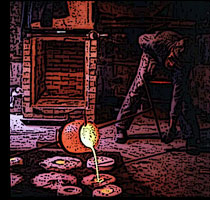|
At this point it might be appropriate to explain how the medals of Karl Goetz were made. The artist himself preferred the medals to be cast instead of being struck from dies. Portrait medals were modeled from wax of plasticine or other modeling material. Opus 547 and 567, for example, were cut directly into Solnhofer stone. The reverse of the medals were usually cut into plaster-of-paris negatives, several immediately into steel. This process demands an extremely good eye and a sure hand on the part of the artist. The plaster negatives were cast into positives and worked over again for detail. From this plaster model a bronze metal mold was made. These, the originals, were chased in order to guarantee a good cast. There is also the method of the "galvano" used. The plaster negative is hung into a bath enriched with copper vitriol and the galvanic current creates a metallic deposit on the plaster negative, which becomes the metal positive. This copper positive is as smooth and clean as the plaster cast. It is very soft, and it can be chased and perfected easily. The casts are then used as originals for future castings.
|
 |
|
Each cast made by Karl Goetz was a Kunst Guss or "artistic casting," and each cast was handmade. This is accomplished by use of the "French sand method." Two sand forms are created by stamping the metal mold into wet sand. Both sandforms are then taken apart; the metals mold is removed; cast holes and vents are provided in both sand form halves; and both are prepared with a graphite powder and dried. The sand forms must be absolutely dry to get a perfect cast. After the sand form halves are joined together the liquid metal is then poured into the sand form. The air escapes through the vents, avoiding bubbles. Only one cast can be made from each sand form. This is the reason for the relatively high price of cast medals. The metal used for casting was mostly bronze, although casts were made in iron, lead, white metal, and silver. Different shades of bronze medals can be explained by the various proportions of copper and tin in the bronze. Experienced casters often added a pinch of liquid silver (mercury) to the bronze in order to ensure the easy flow into the forms
|
|